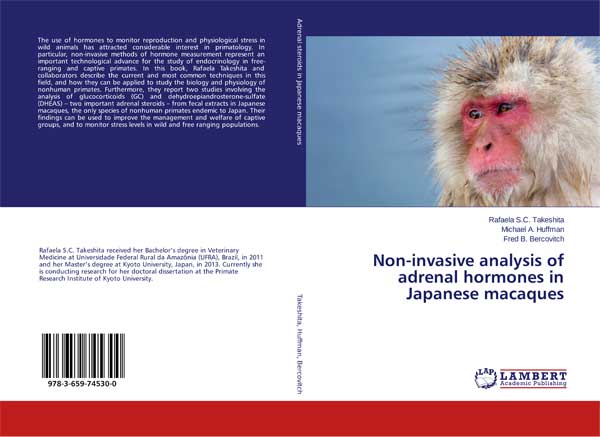



|
TOPICS BONOBO Chimpanzee "Ai" Crania photos Itani Jun'ichiro archives Open datasets for behavioral analysis Guidelines for Care and Use of Nonhuman Primates(pdf) Study material catalogue/database Guideline for field research of non-human primates 2019(pdf) Primate Genome DB 
Primate Research Institute, Kyoto University Copyright (c) |
Japanese Non-invasive analysis of adrenal hormones in Japanese macaques
Rafaela S. C. Takeshita, Michael A. Huffman, Fred B. Bercovitch
Abstract
The ability to determine hormonal profiles of primate populations can help to monitor reproductive status throughout life, physical fitness and physiological responses to environmental changes. We developed and tested a non-invasive method to evaluate the adrenal activity in Japanese macaques (Macaca fuscata) using feces. The subjects were female Japanese monkeys from 2 weeks to 31 years old, kept in captivity at the Primate Research Institute, Kyoto University (25 monkeys living in social groups in outdoor enclosures and 12 monkeys living in single cages housed indoors). We collected fecal samples from all females, and behavioral data from the social group living subjects, during three months of the mating season (October to December) and two months of the following birth season (May to June). These samples were analyzed for adrenal steroids (cortisol and DHEAS) by enzyme-immunoassay at the Section of Social Systems Evolution, Endocrinology Laboratory in the Primate Research Institute. In the first study, we demonstrated that fecal DHEAS levels decrease with age in Japanese macaques housed in outdoor social groups, with extremely high concentrations in neonatal individuals (about 200 times higher than in adults). The second study focused on adrenal hormone response to environmental (physical and social) and biological factors influencing adrenal activity. These results revealed that both fecal cortisol and DHEAS metabolites are higher in females housed indoors in single cages, than in those living outdoors in social groups. We also found that season had an impact on fecal cortisol, but not on fecal DHEAS levels. Cortisol concentrations were higher during the mating (winter) season than the birth (spring) season. Similar to the first study, we found that age is negatively associated to DHEAS levels, but there was an interaction with housing condition. The age-related decline of fecal DHEAS was more evident in females housed indoors in single cages than in females housed in outdoor social groups. Cortisol was also negatively correlated with age, but there was no interaction with housing condition. We did not observe any association of dominance rank with either fecal DHEAS or cortisol. This study showed that measurement of fecal DHEAS and cortisol is a good method to assess stress in Japanese macaques. Our findings provide insights about the physiology of these two adrenal hormones in female Japanese macaques, which can be applied to wild populations and is fundamental for captive management and conservation biology.  2015/07/16 Primate Research Institute
|